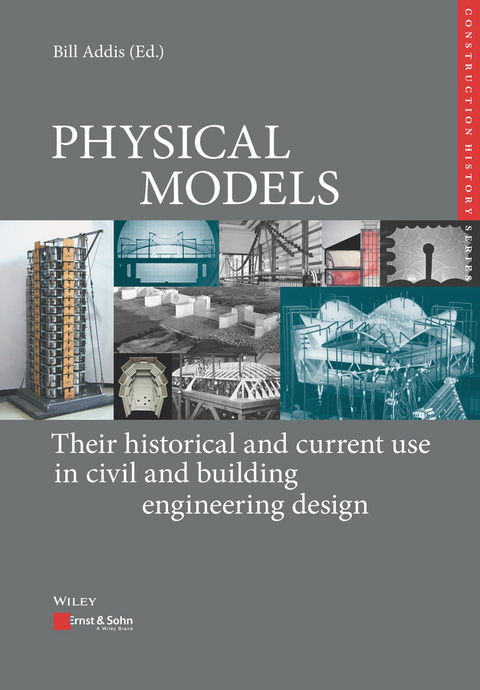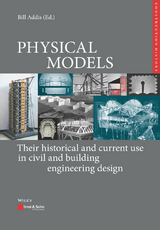PHYSICAL MODELS: Their historical and current use in civil and building engineering design
Ernst & Sohn (Verlag)
978-3-433-03257-2 (ISBN)
Bill Addis (born in 1949), the author of several chapters in the book, and overall Editor, studied engineering sciences and philosophy at the University of Cambridge before working as an engineer in the aerospace industry. He later spent over 15 years in the Department of Construction Management at the University of Reading, and then 15 years as a consulting engineering with the firm Buro Happold in London. He developed his interest in building and civil engineering history, and in the use of model testing during five decades, including work on his doctorate on the history and philosophy of engineering. He has written several books and over a hundred academic papers on the history of building engineering and construction, and has recently been enjoying lecturing and research as a visiting professor in universities in Rome, Innsbruck, San Sebastian, Zurich, Brussels and Munich. He worked for more than 15 years in the academic world, as well as over 15 years with an international firm of consulting engineers.
Preface Construction History Series (by Karl-Eugen Kurrer)
Foreword (by Werner Sobek)
Introduction (by Bill Addis)
SECTION A - PHYSICAL MODELS FROM ANCIENT TIMES TO THE 1880s
1 Dirk Bühler: Models in civil engineering from ancient times to the Industrial Revolution
2 Santiago Huerta: Block models of the masonry arch and vault
3 Rainer Graefe: The catenary and the line of thrust as a means for shaping arches and vaults
4 Andreas Kahlow: Leonhard Euler and the model tests for a 300 metre timber arched bridge in St. Petersburg
5 Dennis Smith: The use of models in early nineteenth-century British suspension bridge design
6 Bill Addis: Models used during the design of the Conwy and Britannia tubular bridges
SECTION B - PHYSICAL MODELS USED IN STRUCTURAL DESIGN, 1890s-1930s
7 Mike Chrimes: The use of models to inform the structural design of dams, 1890-1940
8 Bill Addis: Models used during the design of the Boulder Dam
9 Roland May: The role of models in the early development of Zeiss-Dywidag shells
10 Mario Chiorino & Gabriele Neri: Model testing of structures in pre-war Italy; the School of Arturo Danusso
11 Joaquin Antuna: Eduardo Torroja and his use of models up to 1936
12 Bill Addis: Photoelastic stress analysis
SECTION C - PHYSICAL MODELS USED IN STRUCTURAL DESIGN, 1940s TO 1980s
13 Bernard Espion: Structural modelling technique
14 Christiane Weber: Physical modelling at the University of Stuttgart
15 Mario Chiorino & Gabriele Neri: Model testing of structures in post-war Italy: the activity of ISMES 1951-1974
16 Joaquin Antuna: Eduardo Torroja and his use of models from 1939
17 Edwin Trout: Scale models for structural testing at the Cement and Concrete Association, UK: 1951-73
18 Pepa Casinello: Heinz Hossdorf: his contribution to the development of physical model testing
19 Berthold Burkhardt: Soap film and soap bubble models
20 Lukas Ingold: The model as an ideal building: the origins of the design methods of Sergio Musmeci
21 John Chilton: Heinz Isler and his use of physical models
22 Ian Liddell: Models for the design development, engineering and construction of the Multihalle for the 1975 Bundesgartenschau in Mannheim
SECTION D - PHYSICAL MODELS USED IN NON-STRUCTURAL ENGINEERING DISCIPLINES
23 Bill Addis: The historical use of physical model testing in free-surface hydraulic engineering
24 Bill Addis: The historical use of physical model testing in wind engineering
25 Bill Addis: The historical use of physical model testing in earthquake engineering
26 Raf Orlowski: The historical use of models in the acoustic design of buildings
27 Bill Craig: Geotechnical centrifuge models ? a history of their role in pre-construction design
SECTION E - PHYSICAL MODELLING IN THE TWENTY-FIRST CENTURY
28 Mamoru Kawaguchi: Physical models as powerful weapons in structural design
29 Bruce Martin: Physical modelling of structures for contemporary building design
30 David Wendland: Using physical models in the design of complex masonry structures
31 James Sutherland: Physical modelling of free surface water - current practice
32 Francesco Dorigatti: Boundary-layer wind tunnel model testing - current practice
33 Amarnath Kasalanati: Model testing using shake tables - current practice
34 David White: Geotechnical centrifuge modelling - current practice
35 Raf Orlowski: The use of physical models in acoustic design - current practice
36 Owen Connick: Water-bath modelling - small-scale simulation of natural ventilation flows
37 Jan Knippers: The use of biological models for building engineering design
38 Mamoru Kawaguchi: Flying a 100 metre long Jumbo Koinobori
39 Dirk Bühler & Christiane Weber: Epilogue: A future for models from the past
APPENDICES - Earliest writings in engineering literature about scaling and the use of reduced-scale models
A1 Original source 15BC Vitruvius.
A2 Original source 1638 Galileo.
A3 Original source 1772 Leonard Euler.
A4Original source 1801 Report on Telford's arch bridge across the Thames
A5 Original source 1846 Short article on models in The Builder.
A6 Original source 1847 Short article in Civil Engineer and Architects' Journal.
A7 Original source 1887 part of paper by Osborne Reynolds.
100 word AUTHOR BIOGRAPHIES
| Erscheinungsdatum | 09.09.2020 |
|---|---|
| Mitarbeit |
Herausgeber (Serie): Karl-Eugen Kurrer, Werner Lorenz |
| Verlagsort | Berlin |
| Sprache | englisch |
| Maße | 170 x 244 mm |
| Gewicht | 2056 g |
| Themenwelt | Technik ► Bauwesen |
| Schlagworte | Bauingenieur- u. Bauwesen • Baustatik • Baustatik u. Baumechanik • Bauwesen • Civil Engineering & Construction • Civil Engineering & Construction Special Topics • Geschichte der Physik • History of physics • Materials Science • Materialwissenschaften • Materialwissenschaften / Theorie, Modellierung u. • Materialwissenschaften / Theorie, Modellierung u. Simulation • Physics • Physics Special Topics • Physik • Spezialthemen Bauingenieur- u. Bauwesen • Spezialthemen Physik • Stahlhochbau • Stahlhochbau u. Brückenbau • Steel Construction & Bridge Engineering • Structural Theory & Structural Mechanics • Structures • Theory, Modeling & Simulation • Tragwerke |
| ISBN-10 | 3-433-03257-2 / 3433032572 |
| ISBN-13 | 978-3-433-03257-2 / 9783433032572 |
| Zustand | Neuware |
| Informationen gemäß Produktsicherheitsverordnung (GPSR) | |
| Haben Sie eine Frage zum Produkt? |
aus dem Bereich




